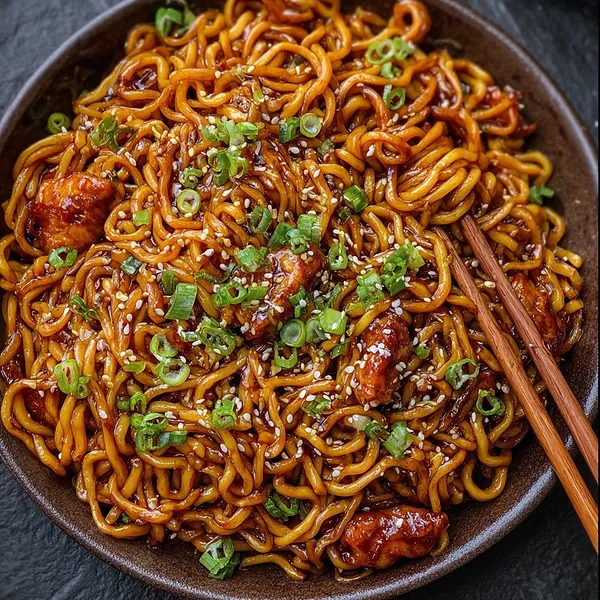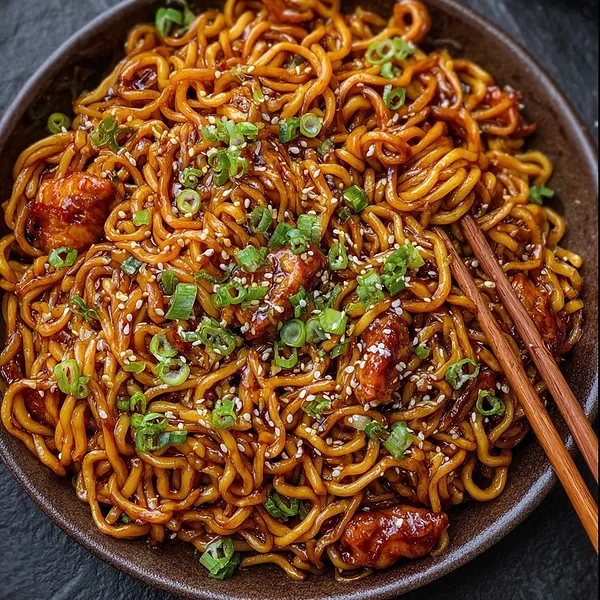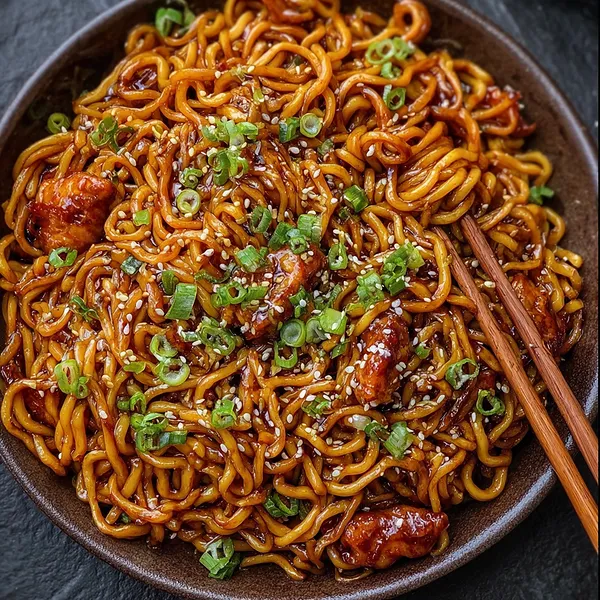 pin it
pin it
I first encountered this style of Korean noodles at a small restaurant in Seoul's Hongdae district, where the ajumma (auntie) behind the counter served them in heavy stone bowls that kept everything piping hot. What struck me immediately was how different these were from any noodle dish I'd had before - the sauce wasn't thin and brothy, but thick and glossy, clinging to each strand with an almost magnetic intensity. The gochujang provided this incredible depth of flavor that was simultaneously spicy, sweet, funky, and umami-rich. When I returned home, I was determined to recreate that experience, but I quickly learned that Korean cooking is all about balance and layering flavors. The key breakthrough came when I understood that gochujang isn't just a hot sauce - it's a complex fermented paste that needs to be balanced with sweetness and acidity. The brown sugar mellows the heat while amplifying the sweetness, and the soy sauce adds that essential umami depth. What I love most about this recipe is how it teaches you to appreciate the art of Korean sauce-making, where every ingredient serves a specific purpose in creating that perfect harmony of flavors that Korean cuisine is famous for.
Why I love this recipe
What makes this recipe so special to me is how it perfectly encapsulates everything I love about Korean cuisine - the bold flavors, the perfect balance of sweet and spicy, and the incredible comfort factor that makes you want to eat it with abandon. There's something deeply satisfying about the ritual of making it - the way the gochujang transforms from a thick paste into a glossy sauce, how the chicken absorbs all those incredible flavors, and the final moment when you toss everything together and watch the noodles get coated in that beautiful red sauce. I love that it's a dish that rewards boldness - the more gochujang you use, the more complex and satisfying it becomes. It's also incredibly versatile and forgiving; you can adjust the heat level, swap proteins, or add vegetables without compromising the essential character of the dish. But perhaps what I appreciate most is how this recipe has become my gateway into Korean cooking. It taught me to stock my pantry with Korean ingredients and introduced me to flavor combinations I never would have imagined. Every time I make it, I'm reminded of the generosity and boldness of Korean flavors, and how food can transport you to another culture and make you feel like you're part of something bigger than yourself.
What You Need From Your Kitchen
- Fresh ramen noodles: cook until just tender, then rinse with cold water
- Chicken thighs: cut into bite-sized pieces for even cooking and tenderness
- Gochujang: the star ingredient that provides spicy, sweet, and umami flavors
- Brown sugar: balances the heat and helps create glossy sauce
- Sesame oil: adds nutty depth and authentic Korean flavor
- Scallions: chop both white and green parts for garnish and freshness
Let's Make These Together
- Perfect noodle texture is key
- Cook the noodles just until tender, not mushy. They should have a slight chew (what Koreans call "jjolmyeon" texture). Rinse with cold water immediately after draining to stop the cooking process and remove excess starch that could make the final dish gummy.
- Balance the gochujang sauce
- Gochujang can vary in heat and saltiness between brands, so taste your sauce and adjust accordingly. The brown sugar should balance the heat while the soy sauce adds umami depth. The mixture should be smooth and slightly thick.
- Create the perfect glaze
- When you add the sauce to the chicken, let it cook until it becomes glossy and slightly caramelized. This concentrates the flavors and creates that signature Korean sauce texture that clings beautifully to the noodles.
- Toss everything with confidence
- When combining the noodles with the sauced chicken, use tongs or chopsticks to toss everything vigorously. The goal is to coat every strand of noodle evenly. If the mixture seems dry, add a splash of the noodle cooking water.
 pin it
pin it
Switch Things Up
I'll never forget my first attempt at Korean noodles - I was so intimidated by gochujang! I bought a tub of it and it sat in my fridge for months because I didn't know how to use it properly. When I finally worked up the courage to try this recipe, I was conservative with the gochujang and the result was bland and disappointing. The second time, I trusted the recipe and used the full amount - what a revelation! The sauce was exactly what I'd been craving - that perfect balance of heat and sweetness that makes Korean food so addictive. Now I make this at least twice a month, and I've experimented with different proteins. Sometimes I use pork belly instead of chicken, other times I'll add some kimchi for extra fermented funk. But this original version with chicken remains my favorite because the meat stays so tender and absorbs all those incredible flavors. The key I've learned is to not be afraid of the gochujang - embrace the heat!
Perfect Pairings
These spicy noodles pair beautifully with cold Korean beer, soju, or even a crisp white wine like Riesling to cool the heat. For side dishes, try kimchi, pickled radishes, or Korean-style cucumber salad. If you want to make it a larger meal, serve with Korean fried chicken or bulgogi. The dish also works well with a simple lettuce salad dressed with sesame oil and rice vinegar to provide cooling contrast.
 pin it
pin it
Frequently Asked Questions
- → Where can I find gochujang?
Gochujang is available at most Asian grocery stores, many regular supermarkets in the international aisle, or online. Look for it in red plastic containers - it keeps for months in the refrigerator.
- → Can I make this vegetarian?
Absolutely! Replace the chicken with firm tofu, mushrooms, or your favorite plant-based protein. You might want to add a bit more soy sauce or use vegetarian mushroom sauce for extra umami.
- → How spicy is this dish?
The heat level depends on your gochujang and personal tolerance. Start with 2 tablespoons if you're sensitive to spice, or go up to 4 tablespoons if you love heat. The brown sugar helps balance the spiciness.
- → What if I can't find fresh ramen noodles?
Dried udon noodles work well as a substitute, or even thick spaghetti in a pinch. The key is using noodles that have some chewiness and can hold up to the thick sauce.
- → Can I meal prep this dish?
This dish is best served fresh, but you can prep components ahead. Cook the chicken and sauce, store separately, then combine with freshly cooked noodles when ready to eat.
Conclusion
These Korean spicy chicken noodles represent the perfect fusion of comfort and bold flavors that Korean cuisine is famous for. The gochujang-based sauce creates an addictive combination of spicy, sweet, and umami that coats every strand of chewy noodle. It's a dish that satisfies on every level - comforting enough for a cozy night in, yet exciting enough to impress guests. The recipe proves that authentic Korean flavors are absolutely achievable at home with the right ingredients and techniques. Once you master this dish, you'll have a new go-to recipe for whenever you crave something deeply satisfying and delicious.
